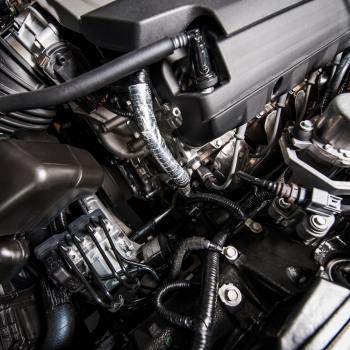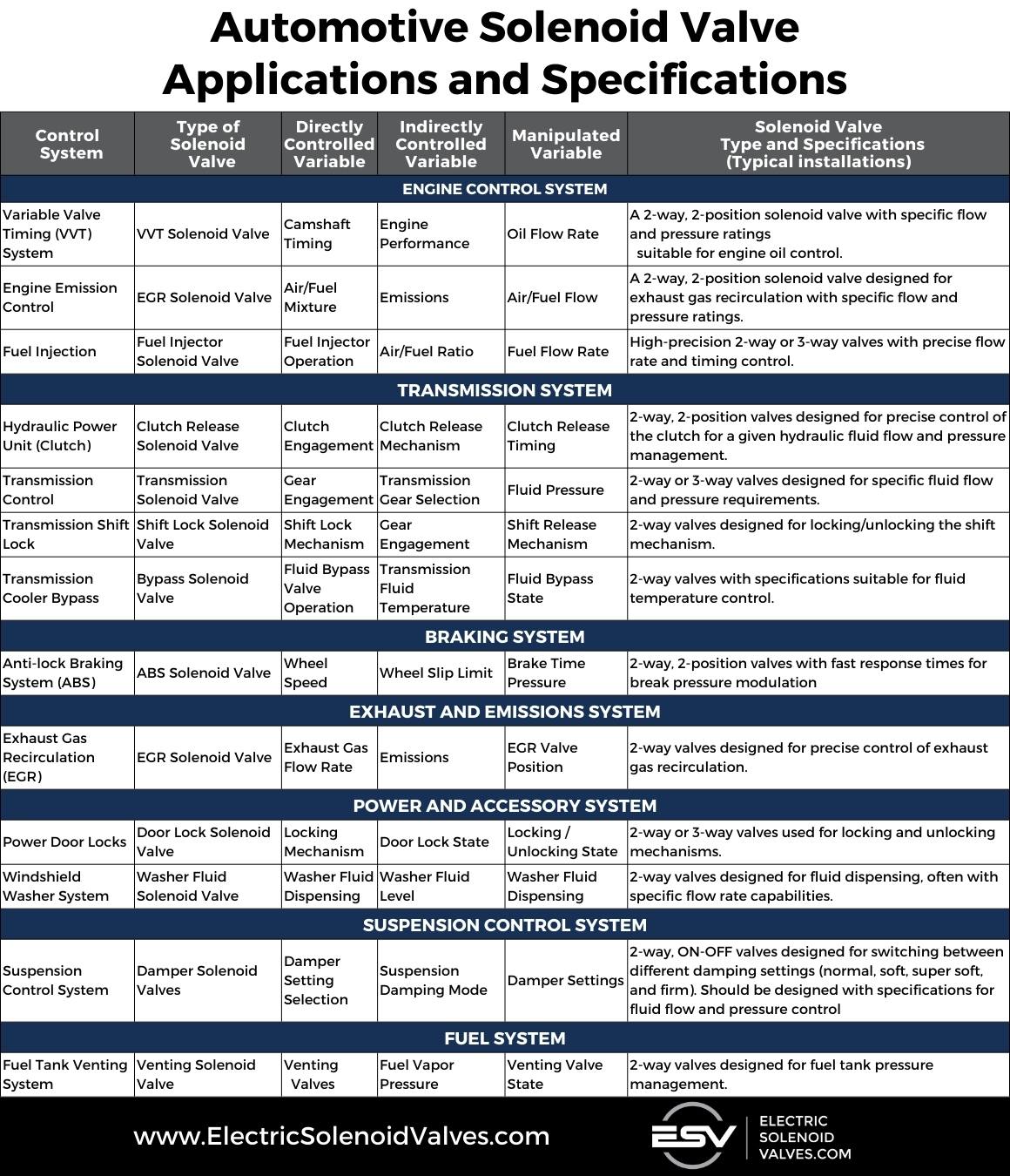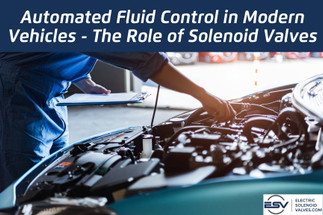Feb 15th 2024
Automated Fluid Control in Modern Vehicles - The Role of Solenoid Valves
In the rapidly evolving landscape of automotive technology, the quest for efficiency, safety, and performance has led to significant advancements in vehicle design and functionality. At the heart of these innovations lies the unsung hero of automotive engineering – the solenoid valve.
These precision-engineered components play a crucial role in managing the flow of fluids throughout a vehicle, from fuel injection systems to cooling and lubrication circuits. Solenoid valves exemplify the seamless integration of mechanical and electronic systems, enabling modern vehicles to achieve higher standards of performance and reliability.
In this article we'll explore the indispensable role of solenoid valves and how they epitomize the technological strides made in automotive design.
Fluid Control Systems in Modern Vehicles:
Modern vehicular systems include a complex and confined web of fluid systems, which must be controlled accurately at each operating condition. Essentially, IC (Internal Combustion) engines are powered by gasoline/diesel fuel, controlled by hydraulic and pneumatic systems, and driven by transmission and brake oils. Auxiliary systems, such as the Engine cooling systems (lube and radiators), passenger comfort systems (air conditioning), and driver assistance systems (steering mechanics and wipers), are also controlled by fluids.
Therefore, at every operational facet of an automobile, fluid control systems are critical for safety and efficiency.

Categories of Fluid Control Systems in Modern Vehicles:
Several categories and combinations of fluid control systems are integrated with modern vehicles. To simplify, we can classify them based on the type of fluid they control (hydraulic, pneumatic), the mechanism they deploy to control the fluid (mechanical, electrical, electro-hydraulic), and the specific function they perform in the vehicle (cooling, power steering, braking, etc.). Here are the two broad categories of vehicle fluid controls:
A. Electro-Hydraulic Driven Fluid Control Systems:
As the name suggests, these systems use electrically controlled hydraulic actuators and solenoid valves to regulate the flow of various fluids within the vehicle systems. Following is a few electrically driven, hydraulically controlled fluid system examples:
- Electro-Hydraulic Power Steering Systems: These systems use an electric motor to drive a hydraulic pump, pressuring the fluid to reduce the steering effort and offer smooth and responsive steering without increasing the engine load. Mostly these are seen in passenger cars and commercial trucks and are supplied by OEMs like Bosch, ZF Friedrichshafen, and TRW (ZF Steering Systems).
- Electro-Hydraulic Brake Systems: Electrical pumps are used to create hydraulic pressure for the braking system, allowing remote brake operation from the engine without the need to run high-pressure hydraulic lines throughout the vehicle. These brakes are popularly seen on high-performance and racetrack cars and are supplied by OEMs like Bosch, Continental AG, and ZF Friedrichshafen.
- Electro-Hydraulic Fuel Injection Systems: These systems use an electric motor to control the pressurization and delivery of fuel from the fuel pump to the engine. Popular suppliers for these systems include Delphi Technologies (now Aptiv) and Denso Corporation.
- Electro-Hydraulic Suspension Systems: Modern electronic control units and hydraulic actuators control the vertical movement of a vehicle’s wheels relative to the chassis. These suspensions are often seen on high-end luxury cars and some off-road vehicles and on brands like Mercedes-Benz (AIRMATIC), BMW (Adaptive Drive), and Audi (Adaptive Air Suspension).
- Electro-Hydraulic Clutch Systems: These systems use an electro-hydraulic control system to regulate the operation of the clutch in a vehicle’s transmission and improve the ease of gear shifts and overall vehicle performance. Often, these high-end clutch systems are seen in sports cars and racing vehicles. OEMs such as ZF Friedrichshafen (SACHS Performance), BorgWarner (LUK), and Eaton (Aeroquip) offer hydraulic clutch mechanisms.
- Electro-Hydraulic Valve Control Systems: Electronic control units and hydraulic actuators control the operation of various valves in a vehicle, such as those in the transmission, lubricant oil circuits, or air-conditioning circuits.
B. Electro-Pneumatic Driven Fluid Control Systems:
Electro-pneumatic systems similarly use electrically controlled valves to regulate the flow of compressed air in vehicles, which in turn controls several fluid mechanisms. Here are a few examples of electro-pneumatically controlled fluid control systems:
- Electro-Pneumatic Brake Systems: Electrically controlled pneumatic valves regulate the air pressure applied to the brake pads, ensuring more precise control of the braking force and improving safety and performance. These systems are best suited for heavy applications and can be seen on trains and commercial trucks. Brands like WABCO (now ZF WABCO), Knorr-Bremse, and Bendix Commercial Vehicle Systems offer pneumatic brakes.
- Electro-Pneumatic Suspension Systems: These actuators adjust the vehicle's suspension and can adapt to road conditions and driving style better than mechanical springs and offer better ride comfort and handling. Found on trams, light rail vehicles, and public transit buses, companies like Siemens Mobility, Bombardier Transportation, and Alstom offer such suspension systems.
- Electro-Pneumatic Clutch Systems: These systems use electrically controlled pneumatic actuators to engage and disengage the clutch, ensuring smoother gear changes and can improve driving dynamics and vehicle performance. Pneumatic clutches are found in heavy machinery such as agricultural vehicles and certain construction equipment. Companies like CNH Industrial (Case IH, New Holland), Caterpillar Inc., and John Deere often use pneumatic clutches on their vehicles.
- Electro-Pneumatic Fuel Injection Systems: Electrically controlled pneumatic valves regulate the air-fuel mixture delivered to the engine, allowing precise control of the combustion process to vehicle drivers, along with improved engine performance and fuel efficiency. These are modern injection systems mostly found in electric vehicles (EVs) and hybrid vehicles as range extenders, which use gasoline-driven IC engines as a backup for battery power. Companies like Bosch, Delphi Technologies, and Continental AG offer these injection systems.
Each of the systems mentioned above is a combination of an electrically driven, hydraulic, or pneumatic control mechanism to operate the flow of fluids for a given application.
Now, before moving on to the automation in Fluid control systems, it is crucial to understand the components that enable fluid control systems to operate in vehicles. Their selection and reliability are extremely critical while offering better performance and precision control to vehicle owners.
Modern Vehicular Fluid Control System Components:
Fluid control systems broadly encompass solenoid valves, process and control valves, electromotive valves, pneumatics and process interfaces, sensors, transmitters, and controllers. Of these, the solenoid valves hold critical importance, and so to limit the article length, we will dwell on the role of solenoid valves in IC Engine-driven vehicles herein.
Imagine the consequences of imprecise fluid control - erratic gear shifts, unreliable brakes, engine malfunctions, and a compromised driving experience. This is where solenoid valves come into play, offering a solution to the fluid control problem that has challenged automotive engineers for decades.
The Function of Solenoid Valves in Vehicle Fluid Control System:

The primary function of an electronic solenoid valve is to efficiently manage the flow, pressure, and timing of automobile fluids. The second important function is ensuring the optimal performance of an automobile and ensuring the safety of the vehicle while in motion.
How does a Solenoid Valve operate in Modern Fluid control systems? At its core, a solenoid valve is a simple, electro-mechanical device. It comprises a coiled wire, or solenoid, and a plunger, which, when the solenoid is energized, moves to open, or close the valve. This operational simplicity is key for precision control with fewer moving components.
Solenoid valves can open or close rapidly, responding to electronic signals with high accuracy. This characteristic has enabled them to be the critical components of modern vehicles, effortlessly and precisely managing fluid flow in various systems.
Among various types of solenoid valves, Direct-operated solenoid valves have the least response time of about 30ms, whereas indirectly-operated solenoid valves can be up to 1000ms or higher. This quick response time allows for precise fluid flow control in various applications.
Application of Solenoid Valves (SVs) in Fluid Control - Where Are SVs Used?
Solenoid valves determine the timing of gear shifts, the firmness of brake application, and the efficiency of power steering assistance. These small devices ensure precise automotive fluid control, ensuring that the right fluid reaches the right place at the right instance. Therefore, the impact of solenoid valves on the driving experience cannot be overstated.
Solenoid Valve integration across various Fluid Control Systems in Automobiles:
The following table shows how every fluid control system in an automobile uses solenoid valves, the specific variable it controls, its effect on the vehicle and driving dynamics, and the type of solenoid valve employed.

While the table offers a detailed view of the importance of solenoid valves in modern fluid circuits, there are further applications of solenoid valves in automotive control systems can vary widely across different vehicle makes and models, such as
- Air Suspension Control: Solenoid valves are often used to control the air supply to the air suspension system, allowing for adjustments in ride height and stiffness for improved comfort and handling.
- Turbocharger Boost Control: Most turbocharged engines use solenoid valves to regulate the boost pressure delivered to the engine, helping optimize performance and fuel efficiency.
- Radiator Fan Control: Solenoid valves are employed to control the flow of coolant to the radiator, to regulate the cooling process and avoid overcooling.
- Transmission Cooler Line Bypass: Vehicles with transmission coolers can use solenoid valves to control the flow of transmission fluid through the cooler, helping to manage transmission temperature.
- Fuel Tank Evaporative Emission Control: These solenoid valves can control the flow of fuel vapors within the fuel tank and are operated by the vehicle's emissions control system.
While further examples and applications of solenoid valves in automobiles can be presented here, the application of SVs are dependent on the specific vehicle, its design, and the intended functions, which are the deciding factors.
Benefits and Importance of Solenoid Valves in Automotive Fluid Control Systems:
While solenoid valves are today widely adopted for most fluid control circuits within automobiles, let us establish the importance of solenoid valves by comparing them with traditional valve systems:
A. Mechanical Valves:
- Traditionally, mechanical valves, such as check valves, throttle valves, and manual shutoff valves, have been used in older automotive fluid control systems.
- Compared to mechanical valves, electrically controlled Solenoid valves offer quicker response times and precise control, making them more suitable for modern, electronically controlled automotive systems.
B. Pneumatic Systems:
- Older and heavier vehicles used pneumatic systems for functions like power brake boosters and air suspensions. Today, they are replaced by Solenoid valves, which are electronically controlled, allowing for more flexibility in adapting to changing conditions and vehicle demands.
C. Manual Valve Systems and Controls:
- Manual levers, switches, and pedals were historically used to control various large diesel-powered engines and their functions. Today, Solenoid valves have reduced the reliance on manual controls by offering a simpler, remotely controlled electric alternative with better reliability and enabling the integration of automation, IoT, and advanced driver assistance systems.
Therefore, Solenoid valves offer several benefits over alternative and traditional fluid control systems. To sum up, the following five reasons elaborate why solenoid valves are irreplaceable in vehicle controls:
- Precision Control: Solenoid valves can control shifts and shift timing by routing or modulating oil through the valve body to the fluid circuits. They can open and close at specific intervals or when a particular event occurs, making them ideal for automated applications.
- Remote Operation: Solenoid valves can be operated remotely, allowing for remote fluid control and integration with the Cloud for data analytics, condition monitoring, and remote operations.
- Fast Acting: Solenoid valves are fast-acting, making them ideal for applications where precise control of fluid flow is needed.
- Versatility: Solenoid valves are incredibly versatile and can be used for electronically controlling the flow of various liquids and gases in different systems. For example, the EVAP purge valve controls the amount of vacuum sent from the intake manifold to the fuel tank, and Variable Valve Timing (VVT) solenoids change the camshaft timing for better horsepower and fuel mileage.
- Energy Efficiency: Solenoid valves set industry standards for reliability, adaptability, and energy efficiency. Their electronically advanced designs work better, longer, and in more hazardous environments.
- Adaptability to Electronic Control: Solenoid valves can be seamlessly integrated with electronic control units (ECUs) and microcontrollers, allowing for precise programming and synchronization with other vehicle functions. This adaptability is essential for the complex electronic control systems in modern vehicles.
- Reduced Maintenance: Solenoid valves are known for their durability and extended service life, reducing the need for maintenance and replacement. This, in turn, results in cost savings for vehicle owners and manufacturers.
Therefore, solenoid valves are increasingly important in modern automotive fluid control systems. Their role will surely broaden as vehicles have become more electronically controlled and technologically advanced, with the growth of EVs, IoT, Automated driving and CANBUS integrations, highlighting the impact of solenoid valves in the automotive industry.
Case Studies - Solenoid Valves Improving the Performance of Fluid Control Systems in Vehicles:
Various researchers and case studies have demonstrated how solenoid valves can significantly improve the performance of vehicular fluid control systems. Here are a couple of case studies we present:
A study by Xiangyang Xu et al. investigated the dynamic characteristics and energy loss in a shifting control system, which is crucial for the performance improvement of an automatic transmission. The researchers compared direct operating solenoid valves and two-stage pilot valves to test their performance in the shifting control system in vehicles.
The results demonstrated that the pressure response time could be improved with a smaller clearance between the spool and the sleeve. And notably, the leakage of the shifting control system employing the direct acting solenoid valve could be reduced by 60% compared to the conventional two-stage pilot valve.
Case Study 2: High-speed on-off valve (HSV) Vs commercial Solenoid screw-in cartridge valve (SCV):
A research paper studies the difficulties of the conventional electro-hydraulic proportional/servo system (EHPSS), which has been widely hailed because of its advantages, such as high-power mass rate and favorable dynamic performance. However, the proportional/servo control valve, a key control element of EHPSS, has the disadvantages of a complex structure, high power losses, contamination sensitivity and high price. Solenoid valves (SCVs) are studied to be the alternate, capable of ensuring low opening times of up to 7.60 ms, with a total closing time of 10.8ms, offering improved dynamic response speed and strengthening the digital hydraulic technology in modern vehicles.
Both these case studies highlight the benefits of solenoid valves in improving the performance of vehicular fluid control systems.
Read More: Solenoid Valves: Failure, Operational & Maintenance Guidelines for Reliable Performance
Conclusion:
Looking ahead, the future of solenoid valves in automobiles is poised for greater integration. As vehicles become more automated and interconnected, solenoid valves will play a crucial role in facilitating this transformation. They will be integral to the development of smart systems within vehicles, enabling real-time monitoring and control of various vehicle functions. This will not only enhance vehicle performance but also contribute to safer and more efficient driving experiences.
However, this future is not without its challenges. The increasing complexity of vehicle systems will demand solenoid valves that are more robust, reliable, and capable of handling extreme loads and running conditions and maintaining low response rates and flow accuracy at higher pressures and temperatures. However, despite the challenges, the potential of solenoid valves in shaping the future of the automotive industry remains immense, underscoring their relevance in the era of vehicle automation.

